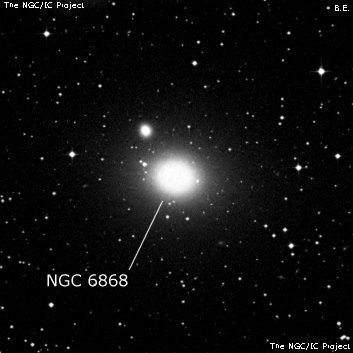
John Herschel discovered NGC 6868 = h3814 on 7 Jul 1834 and recorded "vB; S; R: pgmbM; 20"."
Pietro Baracchi discovered 2MASX J20095889-4821262 off the NE edge, as well as nearby ESO 223-035, while observing NGC 6868 on 5 Oct 1885 with the Great Melbourne Telescope. He noted "[NGC 6868] has a small nebulous spark n.f. (See diagram). Faint, small, flat." "Flat" indicates an even surface brightness.
200/250mm - 8" (7/13/91 - Southern Baja): fairly faint, fairly small, slightly elongated 4:3 N-S, bright core. Pair with NGC 6870 6.2' NNE and brightest with NGC 6861 in a group.
400/500mm - 18" (7/10/02 - Magellan Observatory, Australia): this giant elliptical is one of the brightest members of the Telescopium Group (ACO S851), at a distance of roughly 120 million light-years. At 128x, NGC 6868 appeared moderately bright and large, slightly elongated E-W, ~1.5'x1.2'. Contains a bright core that is concentrated to the center. Forms the southern vertex of an equilateral triangle with members NGC 6870 6' NNE and ESO 233-035 7' NW.
600/800mm - 30" (10/18/17 - OzSky): at 429x; this giant elliptical is the brightest member of the Telescopium Group = ACO S851. It appeared very bright, fairly large, slightly elongated 5:4 WSW-ENE, ~1.8'x1.5' sharply concentrated with an intensely bright core that increases to the center, halo gradually fades. 2MASX J20095889-4821262 is off the NE edge, 1.6' from center, and was fairly faint to moderately bright, round, 20" diameter, weak concentration, with a fairly high surface brightness. NGC 6770 lies 6.3' NNE, ESO 233-035 7.4' NW and NGC 6861F (faint edge-on) 14.5' NE.
Notes by Steve Gottlieb